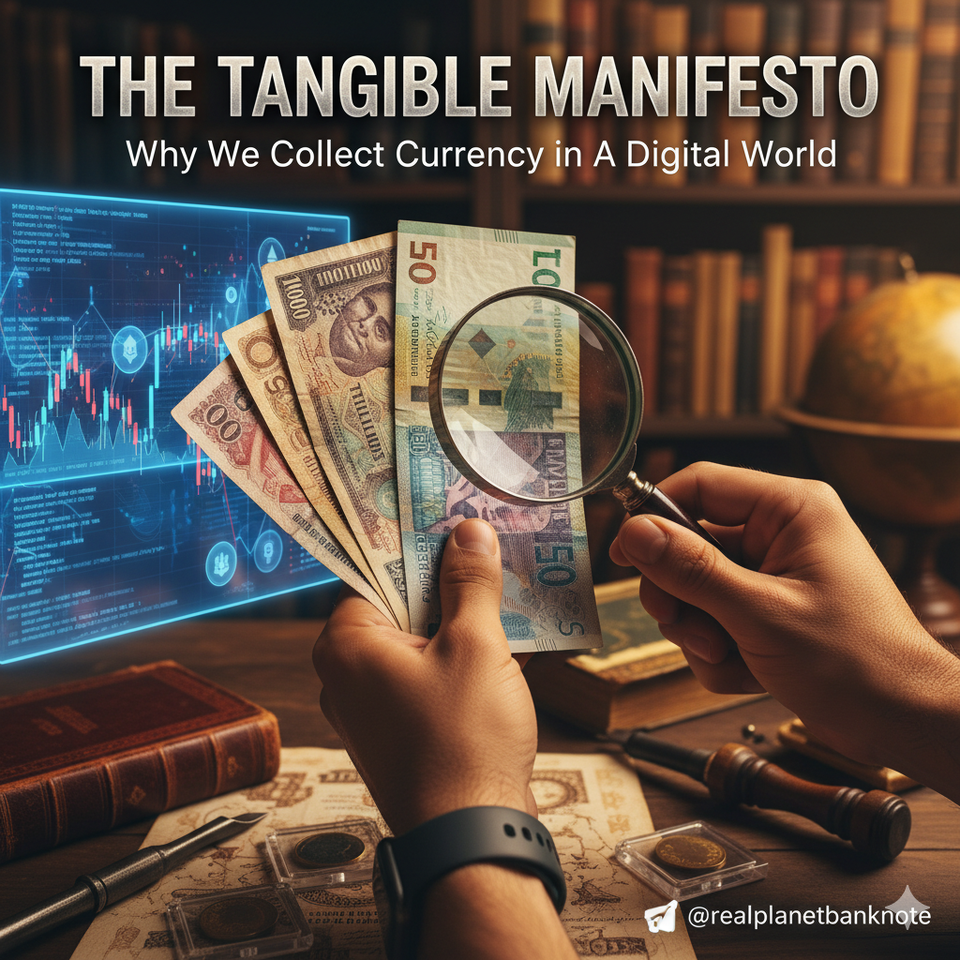The Tangible Manifesto: Why We Collect Currency in a Digital World
The Tangible Manifesto: Why We Collect Currency in a Digital World
Introduction: The New Renaissance of the Physical Note
We exist in a paradox. The primary narrative of our era is one of dematerialization. Financial innovation is defined by "intangibles"
In the face of this digital tsunami, a novice observer might assume that the collection of physical currency—a pursuit centered on paper and polymer—is an obsolete pastime, a relic of a bygone, analog age. This assumption is fundamentally incorrect. The global banknote market is not in decline; it is a robust, multi-billion dollar industry. Market analysis projects the sector's value will expand from $13.15 billion in 2024 to over $20.75 billion by 2032.
This financial data points to a deeper human truth. The hobby of numismatics is not dying; it is evolving.
This leads to the central question: Why? If our world is digital, why is there such a powerful, growing interest in physical banknotes?
The answer is that collecting has evolved. It is no longer "just a hobby." For many, it is a profound and strategic response to the very world that seems to render it obsolete. The more abstract, ephemeral, and "intangible"
In a world of digital fragility, where servers can crash and accounts can be hacked
Reason 1: A Tangible Link to History
The first and most fundamental reason for this renaissance is the power of the physical object. There is a profound psychological difference between holding a banknote in your hand and owning a digital asset. A digital stock or a cryptocurrency coin is, in the end, an abstract idea, a line of code on a server. A graded banknote is a physical artifact. It is a piece of a specific time and place that cannot be erased, deleted, or hacked. It possesses a "materiality" that digital goods lack.
This distinction is the key to "psychological ownership".
In our current age, this need for tangibility has become a search for grounding. A modern life is built on systems of "fragile infrastructures".
Numismatics offers this sense of "permanence".
This pursuit is, in essence, an unconscious act of rebellion against the ephemerality of the digital age. It is a quest for an indelible identity marker. In a world where success and value are increasingly measured by "intangible" metrics
Reason 2: The Ultimate Conversation Piece (The Lesson of Hyperinflation)
While some notes offer a link to stable, proud histories, others are prized for precisely the opposite reason. They are the physical scars of economic catastrophe. These artifacts—our most popular items—are what remain when all three functions of money (medium of exchange, unit of account, and store of value) completely and utterly break down.
Case Study: The Zimbabwe 100 Trillion Dollar Note
There is no more powerful example of this than the Zimbabwe 100 Trillion Dollar note. It is the physical punchline to a tragedy of unimaginable scale. To understand this note, one must understand the economic collapse that birthed it.
In 2008, Zimbabwe's government, in a desperate feedback loop of printing money to pay its expenses, triggered one of the worst hyperinflationary spirals in human history.
But the 100 Trillion Dollar note makes it real.
This note
When you hold this note, you are holding the physical evidence of what happens when a government floods an economy with cash.
Case Study: The Venezuelan Bolívar
A more recent, and equally tragic, example is the Venezuelan Bolívar. As the country's economy collapsed amid political turmoil, resource mismanagement, and hyperinflation
In a poignant act of creative desperation, local artisans began collecting the worthless notes by the brick, weaving them into handicrafts—purses, hats, and "origami venezolano"—to sell to tourists for a few US dollars.
To own a bundle of circulated Bolívares
These hyperinflationary notes have undergone a fascinating "value transubstantiation." They have lost 100% of their monetary value, but in doing so, have gained immense artifactual, educational, and collectible value. There is a "historical irony" in the fact that a note that once "epitomized financial ruin" is now a "profitable opportunity" for collectors.
Its function has irrevocably changed. It failed as a currency.
To codify this lesson, the table below compares three of the most infamous hyperinflationary periods, illustrating the shared patterns of monetary collapse that these notes represent.
| Feature | Weimar Germany (1923) | Zimbabwe (2008) | Venezuela (2018-Present) |
| Peak Monthly Inflation Rate | ~29,500% |
~79.6 Billion % |
~2,000,000% |
| Highest Banknote Denomination | 100 Trillion Mark |
100 Trillion Dollars |
1 Million Bolívares |
| Primary Cause (Simplified) |
WWI reparation payments; passive resistance in occupied industrial zones [31] |
Land reform; political turmoil; unchecked government money printing [18, 19] |
Collapsed oil prices; international sanctions; unchecked government spending |
| Tangible Legacy / Artifact | Notes famously used as wallpaper, fuel, and children's building blocks. |
The 100 Trillion Dollar note, now a prized (and valuable) collector's item. |
"Money origami" |
Reason 3: Collecting as an Art Form
The third pillar of modern numismatics is the appreciation of the banknote as a deliberate, state-commissioned, high-technology art form. Often referred to as "Art Fiduciaire," a banknote is designed to be a "part of a country's symbols" and a piece of its "shared national heritage".
These are not mere receipts. They are "mini-masterpieces" of culture, art, and engineering. Collecting them is akin to curating a private art gallery that represents countries from all over the globe, a gallery that is part history museum and part high-tech exposition. This art form can be deconstructed into three layers: the human hand, the national soul, and the technological marvel.
The Engraver's Art (The Human Hand)
For centuries, the primary security feature of a banknote was the one thing hardest to replicate: the genius of the human hand. In Colonial America, engravers like Benjamin Franklin and Paul Revere printed currency from experimental copper plates.
The pinnacle of this craft was the "vignette"—a small, intricate illustration, often without a definite border.
Symbolism in Design (The National Soul)
Banknote design is a "design challenge"
The results are stunning displays of national identity.
-
The Maldivian rufiyaa, for example, features the artwork of a local artist chosen in a competition, a design the central bank felt "represents the Maldives, and the identity of Maldivians".
37 -
The Swiss 50 Frank note is a masterpiece of abstract symbolism, portraying the "wealth of experience" through the key motive of wind. The obverse features a dandelion's seeds carried on the breeze, while the reverse shows a paraglider soaring over the Alps.
38 -
The Bhutanese ngultrum is famously emblazoned with a vibrant, detailed dragon, a core symbol of the nation's identity.
37
The Art of Security (The Technological Marvel)
In modern banknotes, the security features are not just functional; they are intricately woven into the artistic design. The "manufacturing constraints and security requirements" that "are challenges to the creativity"
This fusion has created a new genre of applied art:
-
Holograms (OVDs): These are not crude stickers but complex, multi-layered artistic elements "registered to the printed design".
39 40 40 -
Watermarks: This is art created by varying the paper's density.
41 42 43 -
Microprinting and Nanoprinting: This is the "secret" art, visible only under magnification.
43 38 -
3-D Security Ribbons: The blue 3-D ribbon on the US $100 note is not printed on the surface but woven into the paper.
35 42 35
This is why the beauty of a banknote is so unique. It is a "constrained art form," and its aesthetic power derives from the tension between artistic vision and technological necessity. The art must be complex
Reason 4: A New Way to See the World
Finally, collecting world currency is a powerful way to understand global cultures, economies, and political stories. Banknotes are a primary medium for expressing national identity, political ideology, and historical narrative. They are, in effect, a "cultural dossier"—a state's "official story" of itself.
When you build a collection, you are opening a window to the world far beyond what can be gleaned from ephemeral headlines. You are holding the primary source documents that nations broadcast to their own people.
Case Study: The Iraqi Dinar (A Nation Reclaiming Its Identity)
The story of the Iraqi Dinar is a powerful narrative of liberation from an authoritarian identity.
-
Pre-2003: The notes of Iraq featured the "common theme among countries with authoritative leaders": the singular portrait of Saddam Hussein.
45 -
The 2003 Exchange: In what was described as a "Herculean, international effort"
46 -
The Symbolism: The most important change was symbolic. As one official stated, "the bad guy's face will be removed from the country's currency".
46 47 47
Collecting these 2003-series notes is to hold the story of a nation actively reclaiming its own identity. It is crucial, however, to differentiate this valid historical and numismatic pursuit from the fraudulent "Iraqi Dinar revaluation" schemes. These high-risk speculative "investments"
Case Study: The Vietnamese Đồng (A Story of Division and Unification)
A collection of 20th-century Vietnamese notes is a physical timeline of the nation's turbulent history.
-
The French Indochinese piastre, representing the colonial era.
52 -
The separate currencies of North Vietnam and South Vietnam, representing a nation divided.
52 -
The "liberation dong" issued immediately after the fall of Saigon in 1975.
53 -
The modern, unified polymer series, representing the current Socialist Republic of Vietnam.
52
The symbolism of the modern notes projects a unified, forward-looking identity. The obverse of every note features President Ho Chi Minh.
Case Study: The Iranian Rial (The Physical Scars of Revolution)
Perhaps no currency tells a story of political change more starkly than the Iranian Rial.
-
Pre-1979: Banknotes from the Imperial era featured the portrait of Shah Reza Pahlavi, along with symbols of "pre-Islamic Iran" and a "pro-Western ideology".
45 -
The Transition (1979-1980): This period produced some of the most fascinating and collectible notes in modern history. The new revolutionary regime, led by Ayatollah Khomeini, despised the Shah's symbols but could not print new money fast enough. Their "quick solution" was to take the existing Shah-era notes and over-stamp them, physically blotting out the Shah's face and watermark with an intricate black design.
45 -
The Artifact: These over-stamped notes are a literal "marker of change".
57 -
Post-Revolution: The new series "personified Iran's new moniker as an Islamic Republic".
45 45 60 61
This is the power of collecting. It is a form of "counter-journalism." While a news report on the 1979 Iranian revolution is ephemeral, holding a note where the Shah's face is physically crossed out
Conclusion & Community Invitation
Whatever your 'why' is—whether you're a historian seeking a tangible link to the past, an artist curating a private gallery, an economist holding a visceral lesson in monetary theory, or a teacher looking for the ultimate conversation piece—you're part of a growing movement.
The way we collect is evolving
We invite you to join the conversation (@realplanetbanknote on Telegram) and then browse our collection to find the next piece of your story.
Explore Popular Articles
More Than Money: The Tangible Assets Drawing a New Crowd
The New Golden Age of Collecting A Market Transformed by Youth, Technology, and Value For decades,...
The Collector's Hierarchy
The Collector’s Hierarchy Understanding Issued, Specimen, and Proof Banknotes In the sophisticated...
The Great Revaluation: Strategic Outlook on Commodities, Equities, and the Return of Tangible Assets (2025–2026)
Executive Summary: The Pivot to Tangible Value The global financial architecture is currently navi...




